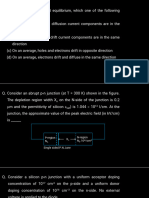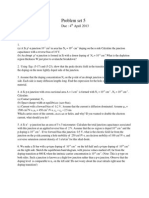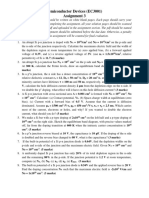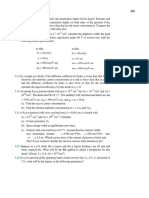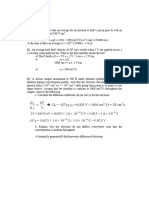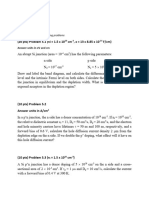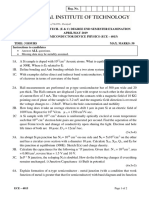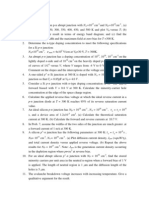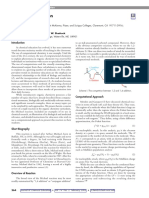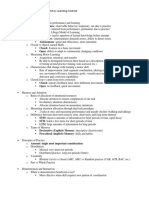Guc 356 64 49019 2024-10-15T09 06 29
Guc 356 64 49019 2024-10-15T09 06 29
Uploaded by
ec441craftCopyright:
Available Formats
Guc 356 64 49019 2024-10-15T09 06 29
Guc 356 64 49019 2024-10-15T09 06 29
Uploaded by
ec441craftOriginal Title
Copyright
Available Formats
Share this document
Did you find this document useful?
Is this content inappropriate?
Copyright:
Available Formats
Guc 356 64 49019 2024-10-15T09 06 29
Guc 356 64 49019 2024-10-15T09 06 29
Uploaded by
ec441craftCopyright:
Available Formats
th
The German University in Cairo Electronics 5 Semester
Faculty of Information Engineering & Technology Semiconductors (Elct 503)
Electronics Department Fall 2014
Problem Set 5
1) An abrupt silicon p-n junction consists of a p-type region containing 2 x 1016 cm-3
acceptors and an n-type region containing also 1016 cm-3 acceptors in addition to
1017 cm-3 donors. [ ni = 1010 cm-3].
a) Calculate the thermal equilibrium density of electrons and holes in the p-type
region & in the n-type region.
b) Calculate the built-in potential of the p-n junction.
c) Calculate the built-in potential of the p-n junction at 400 K.
2) An abrupt silicon pn junction at zero bias has dopant concentration of NA = 1017 cm-3
and ND = 5×1015 cm-3, T=300K
a) Calculate the Fermi level on each side of the junction with respect to the intrinsic
Fermi level.
b) Determine Vbi from the results of a).
c) Determine Vbi from the equation and compare the results to part b).
d) Determine xn & xp and the peak electric field for this junction.
3) Consider the uniformly doped GaAs junction at T=300 K. At zero bias, only 20
percent of the total space charge region is to be in the p region. The built in
potential barrier is Vbi = 1.2 e.v. For zero bias determine
a) NA , b) ND , c) xn , d) xp , e) Emax
4) An abrupt silicon pn junction at T= 300K is uniformly doped with NA = 1018 cm-3
and ND = 1015 cm-3, The pn junction area is 6×10-4 cm2 .An inductance of 2.2
millihenry is placed in parallel with the pn junction.
Calculate the resonant frequency of the circuit for reverse bias voltage of 10V.
5) A silicon p+n junction has for VR1 = 0, C1 = 1.14pF , for VR2 = 3V, C2 = 0.52 pF
and the cross-sectional area of the junction is 5×10-5 cm2. Show that if we plot 1/C2
versus VR , the slope of the curve can be used to find ND and the intersection with
the voltage axis yields Vbi .
6) The total junction capacitance of a one-sided silicon pn junction at T=300K is
measured at VR = 50mV and found to be 1.3 pF. The junction area is 10-5 cm2
and Vbi = 0.95V.
a) Find the impurity doping concentration of the low-doped side of the junction.
b) Find the impurity doping concentration of the higher-doped region.
7) We have a symmetric pn silicon junction (NA = ND = 1017 cm-3 ).If the electric
field in the junction at breakdown is 5×105 V/cm , what is the reverse breakdown
voltage in this junction?
8) The electron concentration along a silicon bar at room temperature is given as:
16 -3
nn(x) = 4 ×10 cm (1- 0.5 ) for 0 < x < L where L= 2 m.x
The electron concentration variations cause a diffusion current, which is
completely compensated by the drift current generated by electric field E(x)
occurring due the slight shift of the electrons in respect to the donor ions.
2 -1 -1
( Jn = 0 for all x ).The electron mobility is μn = 1300 cm V s .
a) Calculate the electric field distribution E(x) needed for compensation.
b) Plot the band diagram along the silicon bar
c) Calculate the diffusion current of the electrons Jn(x).
d) Calculate the space charge distribution ρ(x) causing the field E(x).
e) Determine the build-in voltage occurring between the ends of the silicon
bar.
_____________________________________________________________________
You might also like
- Sri Sadasiva Brahmendra - Yoga Sudhakara (English)Document254 pagesSri Sadasiva Brahmendra - Yoga Sudhakara (English)booksocialist86% (28)
- Physics of VLSI Devices (ECE-5018) Digital Assignment - II: M S G M S GDocument6 pagesPhysics of VLSI Devices (ECE-5018) Digital Assignment - II: M S G M S GShreyas RaoNo ratings yet
- Btap Bán DẫnDocument2 pagesBtap Bán DẫnVu VoNo ratings yet
- Problem Sheet - 1: Figure 1. Conduction Band Figure 2. Valance BandDocument2 pagesProblem Sheet - 1: Figure 1. Conduction Band Figure 2. Valance BandM D0% (1)
- DLL CHS Grade 10Document5 pagesDLL CHS Grade 10Guguk Orquejo100% (3)
- PURIST With Dispenser User Manual - 20190701Document37 pagesPURIST With Dispenser User Manual - 20190701alexblancoNo ratings yet
- Astm A403Document7 pagesAstm A403mtpiping2572100% (1)
- Problem Set 06Document3 pagesProblem Set 06Yasmine ElogailNo ratings yet
- Ee3 Device QuestionsDocument8 pagesEe3 Device QuestionsRahul YadavNo ratings yet
- Guc 356 64 49019 2024-10-15T09 07 54Document2 pagesGuc 356 64 49019 2024-10-15T09 07 54ec441craftNo ratings yet
- Problem Set 07Document2 pagesProblem Set 07Yasmine ElogailNo ratings yet
- HW4Document2 pagesHW4Saied Aly SalamahNo ratings yet
- Numericals Part 4Document19 pagesNumericals Part 4r170176No ratings yet
- Tutorial 3Document1 pageTutorial 3Ma SeenivasanNo ratings yet
- Sample Assignments SDMDocument10 pagesSample Assignments SDMSankar SaroNo ratings yet
- SDP (Sheet-II)2024-25 (2)Document2 pagesSDP (Sheet-II)2024-25 (2)Abhishek Kumar MahatoNo ratings yet
- ProblemsDocument3 pagesProblemsVarshaNo ratings yet
- Model Questions For PMMDDocument4 pagesModel Questions For PMMDlavishNo ratings yet
- Physics of VLSI Devices (ECE5018) - CAT-2 Solutions: Dr. Rajan Pandey Associate Professor, SENSEDocument16 pagesPhysics of VLSI Devices (ECE5018) - CAT-2 Solutions: Dr. Rajan Pandey Associate Professor, SENSEVibha M VNo ratings yet
- Numericals Part3Document20 pagesNumericals Part3shashankmittakola6No ratings yet
- Home AssignmentDocument2 pagesHome AssignmentEffecure HealthcareNo ratings yet
- MM406: Semiconductor Devices and Processing Tutorial 1Document4 pagesMM406: Semiconductor Devices and Processing Tutorial 1Vasit AliNo ratings yet
- Problem Set 5Document2 pagesProblem Set 5Saied Aly SalamahNo ratings yet
- Assignment 3Document2 pagesAssignment 3IdkNo ratings yet
- EEE210 (Physical Electronic)Document57 pagesEEE210 (Physical Electronic)Yavuz KaplanNo ratings yet
- Tutorial Sheet 5 2011 2012Document2 pagesTutorial Sheet 5 2011 2012Sachin KhareNo ratings yet
- Mtech Vlsi TutDocument4 pagesMtech Vlsi Tuttanuj_sharma1991No ratings yet
- EEE210 (Physical Electronic)Document57 pagesEEE210 (Physical Electronic)ozNo ratings yet
- Assignment # 2Document3 pagesAssignment # 2Ms PhysicsNo ratings yet
- Problems: Mobility 2.1Document3 pagesProblems: Mobility 2.1최준범No ratings yet
- HW 2Document2 pagesHW 2b98154No ratings yet
- Exercise 3Document2 pagesExercise 3Erna MaffoNo ratings yet
- NDocument5 pagesNVyne NguyenNo ratings yet
- Guc 356 61 36804 2023-10-15T09 02 53Document5 pagesGuc 356 61 36804 2023-10-15T09 02 53ec441craftNo ratings yet
- VL2021220505858 Da02 PDFDocument1 pageVL2021220505858 Da02 PDFD ChinmayNo ratings yet
- Assignment 2Document9 pagesAssignment 2animeshr991No ratings yet
- EE 101 Practice QuestionsDocument2 pagesEE 101 Practice Questionssagar tiwariNo ratings yet
- ProblemsDocument11 pagesProblemsZeyad AymanNo ratings yet
- Assignment Semiconductor Devices Module 1Document4 pagesAssignment Semiconductor Devices Module 1Shivam Kumar0% (1)
- Junction Phy Tuts 2014Document8 pagesJunction Phy Tuts 2014ESAU0% (1)
- EC 5101 (Microelectronics) Assignment: 17 3 0 F I 15 - 3 F IDocument2 pagesEC 5101 (Microelectronics) Assignment: 17 3 0 F I 15 - 3 F ICmama ChhakchhuakNo ratings yet
- Bab 5 Book-91-98Document8 pagesBab 5 Book-91-98erdin almuqoddas100% (1)
- Wlxz3nlae9xdwvfrtnvmdvzv2pwr04yoa A Gp&Filename Diode+QueDocument4 pagesWlxz3nlae9xdwvfrtnvmdvzv2pwr04yoa A Gp&Filename Diode+QueerjayprakashpatelNo ratings yet
- MOS Assignment 2Document1 pageMOS Assignment 2Ma SeenivasanNo ratings yet
- EEE 2212 Revision QuestionsDocument9 pagesEEE 2212 Revision QuestionsIAMMARKSNo ratings yet
- Semiconductors Quest BankDocument8 pagesSemiconductors Quest BankIslam ShaalanNo ratings yet
- Tutorial Exercises 0: The Basics: E1001 Electronic Circuits Prof P BayvelDocument7 pagesTutorial Exercises 0: The Basics: E1001 Electronic Circuits Prof P BayvelraihanserajNo ratings yet
- Bai tap ban dan_2Document8 pagesBai tap ban dan_2190104 Nguyễn Ngọc Tường VyNo ratings yet
- PHY252 Physics of Semiconductor Devices: InstructionsDocument3 pagesPHY252 Physics of Semiconductor Devices: Instructionskrishna135No ratings yet
- Assignment IDocument2 pagesAssignment IAnupNo ratings yet
- Assignment 3Document2 pagesAssignment 3Shahid KINo ratings yet
- Assignment 4 - Semiconductor DevicesDocument3 pagesAssignment 4 - Semiconductor DevicesikhodiyevNo ratings yet
- Assignment - Electronics Devices and Circuit - Module 2Document3 pagesAssignment - Electronics Devices and Circuit - Module 2ankit sauravNo ratings yet
- SDT 2019Document2 pagesSDT 2019Aniruddh AndeNo ratings yet
- Physics of Semiconductor Devices Homework ExamplesDocument1 pagePhysics of Semiconductor Devices Homework ExampleswazwyNo ratings yet
- HW 1Document1 pageHW 1atulnishadNo ratings yet
- Previous Paper Ism DhanbadDocument7 pagesPrevious Paper Ism Dhanbadravi jaiswalNo ratings yet
- Assignment 2015 2Document2 pagesAssignment 2015 2manish0% (1)
- (Subjective) PN JunctionDocument3 pages(Subjective) PN JunctionAniket SinghNo ratings yet
- Tutorial 5-10092022Document8 pagesTutorial 5-10092022Kota Venkata BharghavNo ratings yet
- HW 4Document2 pagesHW 4Saied Aly SalamahNo ratings yet
- Electron Beam-Specimen Interactions and Simulation Methods in MicroscopyFrom EverandElectron Beam-Specimen Interactions and Simulation Methods in MicroscopyNo ratings yet
- Feynman Lectures Simplified 2C: Electromagnetism: in Relativity & in Dense MatterFrom EverandFeynman Lectures Simplified 2C: Electromagnetism: in Relativity & in Dense MatterNo ratings yet
- Simulation of Transport in NanodevicesFrom EverandSimulation of Transport in NanodevicesFrançois TriozonNo ratings yet
- Media and Information Literacy (Mil) : Introduction To MIL (Part 3)Document69 pagesMedia and Information Literacy (Mil) : Introduction To MIL (Part 3)Neil John De VeraNo ratings yet
- CH 10 Financial Performance Measures and Their EffectsDocument17 pagesCH 10 Financial Performance Measures and Their EffectsFernandaNo ratings yet
- Action Plan of Manimala PDFDocument31 pagesAction Plan of Manimala PDFSheth ShrutiNo ratings yet
- Potentiostat 605 ManualDocument43 pagesPotentiostat 605 ManualSaheed AdewaleNo ratings yet
- BRO DeltaV SIS System OverviewDocument20 pagesBRO DeltaV SIS System OverviewJose Luis DJNo ratings yet
- Illustrative Example: A Blending Process: An Unsteady-State Mass Balance For The Blending SystemDocument23 pagesIllustrative Example: A Blending Process: An Unsteady-State Mass Balance For The Blending Systemsneha_21No ratings yet
- What Is Cable Schedule and Junction Box ScheduleDocument4 pagesWhat Is Cable Schedule and Junction Box Schedulezhangyili100% (1)
- Ais Connection ProcedureDocument4 pagesAis Connection ProcedureKuang Ah HockNo ratings yet
- April 2020 PTE 2 PathfinderDocument54 pagesApril 2020 PTE 2 PathfinderBadmus AyomideNo ratings yet
- New ASE CI Brochure Final 2020Document4 pagesNew ASE CI Brochure Final 2020lalegendegnancaime TvNo ratings yet
- BTS3911E Hardware DescriptionDocument36 pagesBTS3911E Hardware DescriptionCici MinartiNo ratings yet
- Fib Gann AnalysisDocument2 pagesFib Gann AnalysisRajesh RajagopalNo ratings yet
- EKL Catalogue of 2015 Part 1Document33 pagesEKL Catalogue of 2015 Part 1joyceNo ratings yet
- Shida: - EvarDocument107 pagesShida: - Evarpravin mundeNo ratings yet
- The Michael ReactionDocument4 pagesThe Michael ReactionJennifer Carolina Rosales NoriegaNo ratings yet
- Making and Curing Concrete BeamsDocument5 pagesMaking and Curing Concrete BeamsjjaavenidoNo ratings yet
- Mini Project 2 SemDocument32 pagesMini Project 2 SemASHIRWAD RUHELANo ratings yet
- Vishwa Patel FIFA 20215041Document10 pagesVishwa Patel FIFA 20215041Vishwa PatelNo ratings yet
- Warehousing Unit - 3Document55 pagesWarehousing Unit - 3pramav2411No ratings yet
- Runways: Bergen Lufthavn, Flesland Norway Aerodrome Chart IcaoDocument1 pageRunways: Bergen Lufthavn, Flesland Norway Aerodrome Chart IcaoEmmaNo ratings yet
- FORMAT Prelims 7Ps AND 4Ms FADocument34 pagesFORMAT Prelims 7Ps AND 4Ms FASelle FlorendoNo ratings yet
- Motor Learning ReviewDocument2 pagesMotor Learning Reviewbob poopersteinNo ratings yet
- High Density Polyethylene Pipe Hdpe Pe 100 Page 22 23Document2 pagesHigh Density Polyethylene Pipe Hdpe Pe 100 Page 22 23Tony JamesNo ratings yet
- Ch-8 Motion: Difference Between Uniform and Non Uniform MotionDocument4 pagesCh-8 Motion: Difference Between Uniform and Non Uniform MotionBdbdhrhrjruhrhrNo ratings yet
- Ken Arkind EPK FinalDocument4 pagesKen Arkind EPK FinalAnonymous pjgPNANfNo ratings yet
- Chronic Myeloid Leukemia (CML) 3Document1 pageChronic Myeloid Leukemia (CML) 3Augustine A. KollieNo ratings yet












